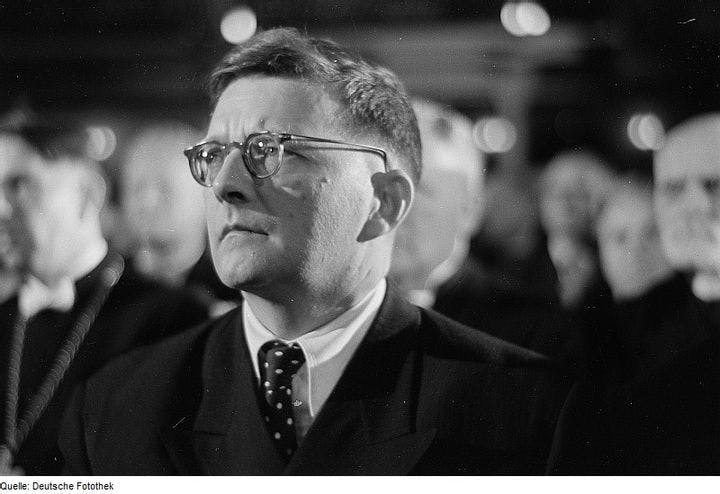Spring 2011
A Life Set to Music
– Miles Hoffmann
Shostakovich managed to turn the simplest of musical building blocks into extraordinary musical structures of vast emotional range, all while living a strange double life as both privileged beneficiary and tormented victim of the Soviet regime.
Wendy Lesser discovered the string quartets of Dmitri Shostakovich and fell in love. I admire her passion for this music, and I understand her fascination with the composer. At his best, Shostakovich (b. 1906) managed to turn the simplest of musical building blocks—melodies and rhythms of often-striking banality—into extraordinary musical structures of vast emotional range, all while living a strange double life as both privileged beneficiary and tormented victim of the Soviet regime, under which he lived until his death in 1975.
This book, however, adds little of consequence to the study of the music or the man. Lesser is a cultural critic, a novelist, and the editor of the literary journal The Threepenny Review, and she writes well. Sadly, though, she calls her reliability into question right away when she declares that Shostakovich’s “own voice” cannot be heard “in even the best of his symphonies,” a surprisingly sweeping assessment from a non-musician who conceded a page earlier that she has listened only to “most” of the composer’s 15 symphonies. Later, she gives a nuanced analysis of the Soviet author Mikhail Zoshchenko’s use of language—without mentioning that she doesn't speak Russian.
Distressingly, much of Lesser’s account of Shostakovich’s life consists of material and insights that appear in previous biographies. Time and again, she uses others’ stories as if she were the one who had realized their illustrative value. I kept Elizabeth Wilson’s important compendium, Shostakovich: A Life Remembered (1994), at hand as I read, and though Lesser acknowledges her debt to the book—calling it “a major source” and citing it frequently—I was struck nonetheless by how often she weaves Wilson’s stories into the narrative as if the syntheses were her own.
To cite but one example: In an anecdote about the Twelfth String Quartet and Dmitri Tsyganov, the violinist to whom the quartet was dedicated, Wilson writes, “When Tsyganov anxiously brought up the subject of serialism, Shostakovich retorted, ‘But one finds examples of it in Mozart’s music.’” Lesser retells the same story: “And when Tsyganov voiced concerns about the explicitly serial elements in the quartet, Shostakovich apparently answered him by saying, ‘But one finds examples of it in Mozart’s music.’ ” The only credit she gives Wilson is for the direct Shostakovich quote.
Music for Silenced Voices is based on two major premises. The first is that because Shostakovich’s string quartets—15 in all—flew under the radar of suffocating Soviet scrutiny, the composer was able to fill them with music that was more “pure” and “personal” than the music of his symphonies—the implication being that the quartets are the key to a true understanding of Shostakovich and are somehow of greater value than most of his more famous and “public” works.
This is an argument clearly based on personal preference and enthusiasm. One could easily make the case, for example, that nothing could be more personal or revealing than the manner in which an artist responds to obstacles and duress. As Igor Stravinsky once wrote, “Whatever diminishes constraint, diminishes strength. The more constraints one imposes, the more one frees one’s self of the chains that shackle the spirit.” Lesser is so wedded to her theory of the quartets’ unique status that she casually dismisses the opinion of the distinguished conductor Maxim Shostakovich, the composer’s own son, who said of his father’s work, “His quartets and his symphonies—yes, it is the same circle of feelings, just on a different scale.”
The book’s second major premise is that readers will want to be told quite specifically what “we” hear and feel in each quartet. Lesser informs us that the Seventh Quartet, for example, “is not asking for sympathy, nor is it crying tears over its own sorrow,” and that “in the Adagio fourth movement [of the Third Quartet] we are dead.” She is certainly entitled to feel and hear whatever she likes, but as converts and zealots often do, she overestimates the interest to others of her particular “good news.”
Cultural historian Jacques Barzun once wrote that the critic must not “blur in the minds of his readers . . . the difference between words and music.” To the extent that Wendy Lesser has communicated her enthusiasm and encouraged readers to delve deeply into the Shostakovich quartets, she has done the music a service. To the extent that she has imposed her own limited and limiting interpretations on the reader, she has not.
* * *
Miles Hoffmann is violist and artistic director of the American Chamber Players and music commentator for NPR's Morning Edition. He is the author of The NPR Classical Music Companion (1997).
Reviewed: "Music for Silenced Voices: Shostakovich and His Fifteen Quartets" by Wendy Lesser, Yale University Press, 2011.
Photo courtesy of Wikimedia Commons
